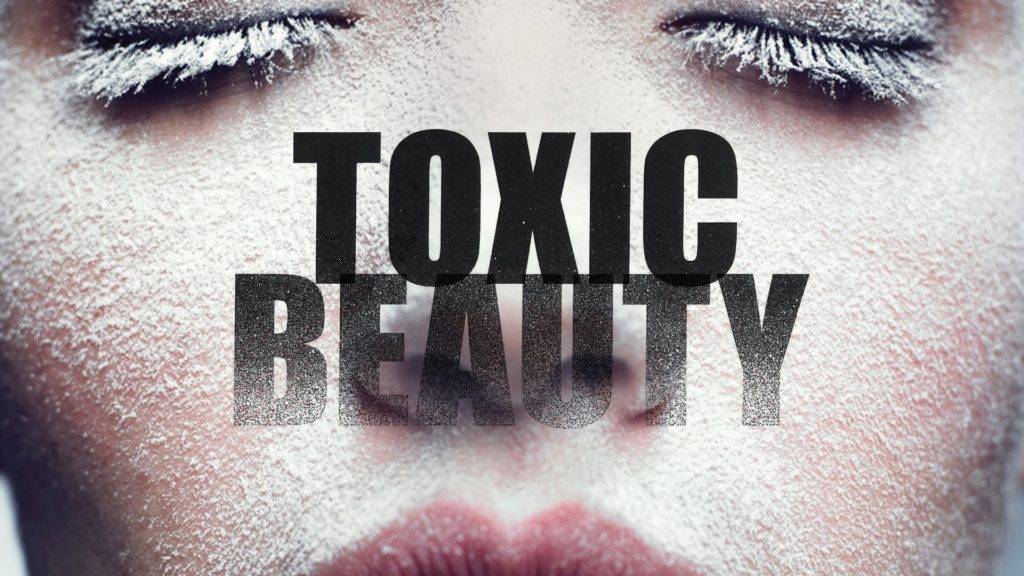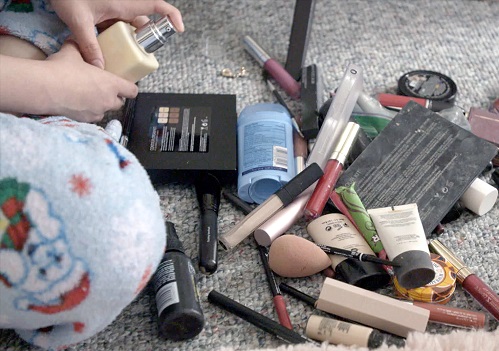Each morning we slather our faces and bodies with thousands of chemicals hidden inside cosmetics and personal care products, many of which can be toxic. Talc, for example, the main ingredient in baby powder, has been linked to ovarian cancer for decades. Yet, Johnson & Johnson (J&J) continues to put their baby powder on our shelves, without any warning labels – and despite having already paid billions in punitive damages to women who’ve successfully argued that claim (a Canadian lawsuit is ongoing too).
In 2004, Dr. Philippa Darbre, a UK scientist, found parabens, a chemical preservative in many cosmetics, in breast tissue. In 2018, the National Institute of Health’s sister study linked breast cancer to personal care product use. Just some of the many stories that make us wonder why more isn’t being done to protect people from the products they use daily.
The documentary, Toxic Beauty, is an eye-opening, riveting and frightening look at the little-regulated beauty industry, with the backdrop an ongoing class action lawsuit against J&J. Incorporating interviews with scientists, lawyers, advocates, regulators, a whistleblowing powerhouse and women who have since lost their lives, Toxic Beauty is a must-see for anyone who believes big industry and regulators are looking out for their best interests. Woven throughout the film is a human experiment by Boston University medical student, Mymy Nguyen, who measures her chemical body burden from more than 27 products as scientists monitor and share the shocking results.
Having already made the rounds at film festivals, the film can be found on Amazon, iTunes, demand.film and is streaming in Canada at CBC Gem. Written and directed by Canadian filmmaker Phyllis Ellis, the film ultimately begs the question: are cosmetics and personal care products making us sick? We recently sat down with Ellis to chat about the film, what inspired her work, any updates on the lawsuit, and advice for those of us wondering who to trust and how to make smarter choices when purchasing personal care products.
How did you learn about the lawsuit with Johnson & Johnson? Do you have any updates on where the Canadian lawsuit stands today?
When we started researching the topic of toxicants in cosmetics and personal care products, we knew we needed real women, a narrative to follow and one that had solid research and science behind it. Dr. Daniel Cramer, who was one of our first interviews explained in detail his story, research and relationship to finding a causal link between talc and ovarian cancer in 1982. He was really our entry into that story.
But I had read in the media about the J&J talc litigation prior to meeting him. Then I met Joel Rochon, who is one of the lead lawyers on the Canadian litigation. I don’t have a current update on the Canadian lawsuit only to say that there are hundreds of women and the team is very committed to justice for them.
Are there those still pushing the argument that there’s no link between Talc and ovarian cancer? Or do you feel the link is more accepted today (after the lawsuit)?
From what certainly Dr. Cramer and attorney Allan Smith have communicated, any strong push toward the argument that there is no link is likely research supported by industry. What we learn in the film, through our expert independent scientists, researchers and also through the first congressional hearing on talc March 2018, is that there is in fact a direct link between talc and ovarian cancer.
Documentary Toxic Beauty explores the chemicals and toxins in our cosmetics and personal care products
Many would be surprised to learn that their beauty products don’t have warning labels on them, despite research proving they can be harmful. How can women take better care of themselves in this environment?
That’s the multi-billion-dollar question. Now that we are aware of the issues around regulation or lack there of, we need to be informed. Check labels on new purchases, and also the products we are using daily on ourselves, children and loved ones. And there are a couple of app’s, although not always reliable or might not cover your brand, like Think Dirty or Skin Deep. At least it’s a reference.
Be very careful with any products that have the word fragrance or parfum. We learned that those words can contain hundreds of chemicals and some of those chemicals can be harmful. But they are not labeled. They don’t have to be listed, as most ‘fragrance’ is proprietary.
What has been the response to your movie by J&J and others in the cosmetic industry?
I haven’t heard from anyone. Not during filming or after. Some turned down interviews.
What are some things we can all do to change the industry and its lack of regulation and silence on these issues?
Contact your MP and tell them we need to push stricter and more fulsome regulations on cosmetics and personal care products. Reduce, reduce and remove products from your daily routine. We all likely know this but not many products do what they say they will do so if we stop purchasing then the brands will have to reformulate.
Phyllis Ellis is the director of Toxic Beauty. She’s a creator, writer, director, producer and performer in factual and scripted television and film.
TOXIC BEAUTY has made the rounds at festivals, in theatres, been broadcast, and is still in demand. The can be found on Amazon, iTunes, demand.film and is streaming in Canada at CBC Gem.



